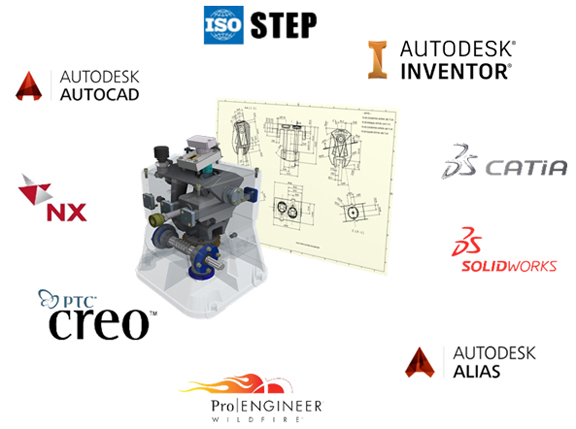
Autodesk Inventor 2018 features enhancements in AnyCAD technology, first introduced in Inventor 2016, to tackle multi-format design workflow (image courtesy of Autodesk).
Latest News
March 29, 2017
Last week, Autodesk released Autodesk Inventor 2018, the latest version of its flagship mechanical modeling program. (For more on the release, read “Autodesk Inventor 2018 Has Arrived,” March 24, 2017.) The new release touts, among other things, enhancements to its AnyCAD environment, for working with 3D files from other CAD programs.
AnyCAD made its debut in Autodesk Inventor 2016, as a way to let Inventor users incorporate non-Inventor files into their designs. Like most standard CAD packages, Inventor lets users import 3D files made with other CAD programs (such as Solid Edge, PTC Creo, or SOLIDWORKS) by converting them into neutral CAD formats, such as STEP, IGES, or OBJ. The translation process adds time to the design cycle. It’s not always smooth or straightforward. Missing surfaces, misaligned geometry, and other translation mishaps are well-known to CAD users. Inventor’s AnyCAD technology is meant as a better alternative to this traditional approach.
“Now, it doesn’t matter what file type you’re working with. Inventor treats them all as if they were native with no need for translation,” says Autodesk in its video announcing the feature. “What’s more? Inventor can recognize the associative values, so if [the design] gets updated, the associated values update too.”
 Autodesk Inventor 2018 features enhancements in AnyCAD technology, first introduced in Inventor 2016, to tackle multi-format design workflow (image courtesy of Autodesk).
Autodesk Inventor 2018 features enhancements in AnyCAD technology, first introduced in Inventor 2016, to tackle multi-format design workflow (image courtesy of Autodesk).Multi-format, multi-version solution
With version 2018, you can use AnyCAD to open and edit not only files from rivals but from older versions of Inventor. “It will allow a user of an older version of Inventor to reference a future file format into their assembly, providing basic backward compatibility,” writes Jon den Hartog, Autodesk senior product manager for Inventor, in a blog post.
So what’s happening under the hood when you apply AnyCAD to files created in other CAD packages?
“With AnyCAD in Inventor 2018, a reference to the native third party format is maintained. Inventor does not convert that third-party file to an Inventor format (.ipt or .iam),” explains Loren Welch, Autodesk Inventor product manager. “Once the files are inserted with AnyCAD, Inventor users can add new features to the file with direct or parametric modeling workflows. [If you edit that referenced file,] the new [geometric] features are saved in the Inventor file that contains the referenced data. If a user chooses, they can remove the reference to the native third party file and from that point forward treat the data as an imported solid.”
ECAD integration gains momentum
Like other CAD programs, Inventor also faces the challenge of facilitating file formats produced by electrical CAD (ECAD) software users. The popularity of connected devices driven by IoT forces MCAD and ECAD users to collaborate more, thus the need for MCAD-ECAD interoperability.
“Inventor has maintained its long standing associativity with AutoCAD Electrical for routing electrical components in a user’s 3D design. Inventor also has had the ability to read in PCB design data in IDF format. When reading in PCB design data, Inventor users can choose between simplified components or a specified component library,” says Welch.
As the scale and scope of collaboration increase in manufacturing projects, the ability to work with data produced in any CAD package becomes a sought-after feature in engineering software. Autodesk rival PTC and SolidWorks tackle the same challenge with PTC Creo Unite and SOLIDWORKS 3D Interconnect, respectively.
To bridge MCAD and ECAD, Autodesk rival PTC offers the PTC Creo MCAD-ECAD Extension. SolidWorks offers SOLIDWORKS PCB, based on the technology of a SolidWorks partner and ECAD developer Altium. This week, Siemens PLM Software announced the completion of its acquisition of Mentor Graphics, an ECAD software developer. The transaction gives Siemens PLM Software the ability to incorporate ECAD viewing and editing functions into its CAD programs.
Autodesk Inventor and its rivals are in a constant struggle to prove their superiority over one another. CAD interoperability is the old battleground where they can outshine the competition. The integration of ECAD is the new frontier.
Subscribe to our FREE magazine, FREE email newsletters or both!
Latest News
About the Author
Kenneth Wong is Digital Engineering’s resident blogger and senior editor. Email him at [email protected] or share your thoughts on this article at digitaleng.news/facebook.
Follow DERelated Topics






